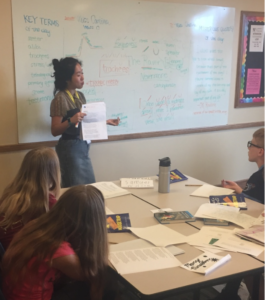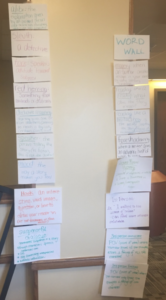Summer SAVY 2018: Session 4, Day 3 – Mysterious World in Writing (Rising 5th/6th)
Dear Parents:
Happy Wednesday! We’re nearing the middle of our mysterious world in writing, and students are eager to share their stories with you all on Friday.
We began the day with Minute Mysteries. Students were assigned new seating groups today, so they have a chance to interact with other peers in the class and get to know new mystery-writers. At their new tables, students were given short “riddles” (Minute Mysteries). One person at each table was the designated mystery-keeper (with the answers); everybody else worked collaboratively as a detective to solve the riddle. Detectives could only ask Yes/No questions to the mystery-keeper, in order to crack their case. The purpose of this exercise was for students to understand and actively apply the process of Deductive Reasoning. By asking only Y/N questions to solve the riddle, they had to begin with broad questions, and then narrow down until they accessed results. All detectives in the class successfully cracked their cases! We reviewed the process of Deductive Reasoning, and discussed how to incorporate this into our own writing.
Next, we moved onto a short Review of current vocabulary and literary techniques. Students contributed to a class discussion for this part of the morning, and terms were clarified, revisited, and written on the board. With this review in mind, students were able to spend 20 minutes or so continuing the writing of their mystery stories, and encouraged to apply all techniques into their writing.
We transitioned into reading Edgar Allen Poe’s poem, “The Raven,” as an example of trochaic meter and suspense-building rhythm within a literary text. Students read the poem out-loud in round-robin style, and we discussed the content/plot summary of the poem, The Raven’s symbolism, the purpose of repetition, as well as meter, stressed/unstressed syllables, and trochees in the poem. We talked about how different words, depending on their stressed/unstressed syllables, might have certain suspenseful, grim, eerie or forceful effects. We considered using trochees within our own mysteries.
Before Lunch, we then began a lesson on Crafting Scenes within our mysteries. Students reviewed the basic story plot arc elements of exposition, rising action, climax, falling action, and resolution, and we discussed how Scenes in literature (action-based, individual story units that reveal place and time, characters’ actions, reactions, dilemmas) usually also contain a mini story arc within themselves. Students read short, one-page scenes from The Hardy Boys: Footprints Under The Rug, and Harry Potter: Chamber of Secrets. They were asked to write down a list of “Action Verbs,” verbs that they thought were important to the Scene, on paper. They were also asked to record the basic story arc of each scene on paper. We discussed all of this as a class, and also tactics for how to write an effective scene: character development, dialogue, imagery, show/don’t tell, specific place/time/setting.
In the afternoon, we spent some more time working on our mysteries (thinking about Scene development). Students were required to choose one scene, pick out all the action verbs in their scene, plot its plot elements, and then think about ways to re-infuse more exciting verbs (or, just more verbs in general!) within their individual scenes.
Moving onto The Mousetrap, which seems to be a class favorite this week. We read (out-loud) half of Act II of The Mousetrap today, pausing every few pages to discuss Christie’s methods of building in suspense through actions in addition to dialogue. Students began creating a chart of all characters to assist with their reading, so that they can better map out as readers where suspense begins building, where the rising action is, and who they might ultimately believe is the culprit. We had another fantastic reading; bravo to all the student readers who played their parts so wonderfully. I’m sure students will be eager to discuss the Mousetrap story plot and their own convictions thus far about characters. I encourage you to discuss these at home with your students, and ask them for specific textual details and examples to support their claims.
In the latter half of class, we discussed The A-Ha! Moment of mysteries — or, how to conclude/end your mysteries. We discussed endings that: answer pressing questions they’ve posed for readers, link up clearly to the story (and don’t go completely left field!), reveal truths about characters who were seemingly suspicious, clear up any red herrings, and leave the reader feeling fully satisfied. Students had the last twenty minutes of class to work on their writing.
Tomorrow, we will begin talking about the art of revision in the writing process. To prepare your students, consider asking them: What does it mean to revise? How might revision be different from simply rewording things in a story? We’ll go more in-depth about this process with students tomorrow, and they’ll have a chance to peer-review their classmates’ works!
That’s it for another jam-packed, creative day. I look forward to tomorrow.
-Miss Carlina
Some Photos From Our Day

